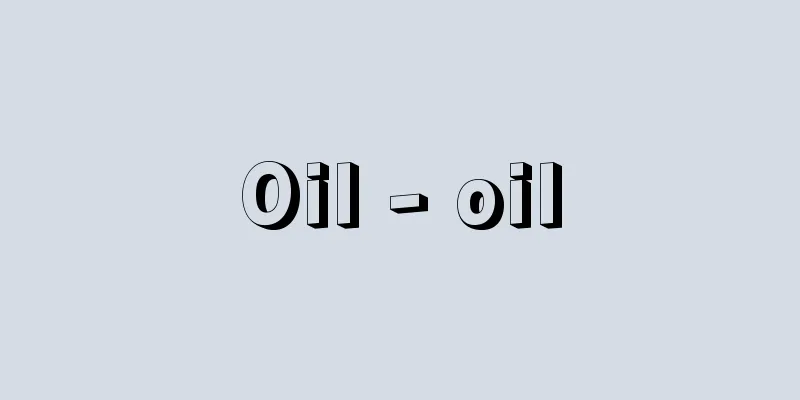Oil - oil

|
Oils are generally defined as substances that are liquid at room temperature, flammable, and poorly soluble in water. They are broadly classified into animal and vegetable oils, mineral oils, and essential oils. Oil type(1) Animal and vegetable oils Oils that are liquid at room temperature are called fatty oils, and those that are solid are called fats or grease. Animal and vegetable oils are generally composed of triglycerides of higher saturated or unsaturated fatty acids. Vegetable oils contain a lot of unsaturated fatty acids, while animal fats contain a lot of saturated fatty acids. Vegetable oils do not contain cholesterol, while animal fats do. Depending on the iodine value, which is the number of grams of iodine absorbed by 100 grams of fat or other oil, oils are classified as drying oils (130 or more), semi-drying oils (100-130), and non-drying oils (100 or less). Soybean oil and rapeseed oil are used as edible oils, while linseed oil is used for paints. Fatty acids and glycerin are obtained by hydrolysis of animal and vegetable oils, and hardened oils are obtained by hydrogenation. Hardened oils are used in margarine, soap, etc. (2) Mineral oil: Includes petroleum and petroleum fractions such as gasoline, naphtha, kerosene, diesel, heavy oil, and shale oil. The main component of petroleum is hydrocarbon, and it contains small amounts of sulfur, nitrogen, and oxygen. Petroleum is used as a raw material in the petrochemical industry to produce fuel and organic chemical products. When the word "oil" is used in automotive terms, it often refers to lubricating oils such as engine oil and brake oil. (3) Essential oils are volatile oils obtained from the flowers, leaves, stems, etc. of plants, and are plant-based fragrances. These aromatic oils consist of terpene hydrocarbons, etc. When aromatic oils are extracted from the raw materials with fats or oils, they can be used immediately as perfume oils in cosmetics. [Kazuo Fukuzumi] The magical and religious meaning of oilIn the context of magic and religion, animal fat and vegetable oil were considered to be carriers of supernatural power. The custom of eating and drinking the blood and flesh of humans and animals to acquire spiritual or magical power is found all over the world, but the custom of applying animal fat or vegetable oil to the body and other parts is also widely seen in various places. It is believed that by applying it, the spiritual or magical power inherent in the fat or oil is transmitted to the person (or object) on which it is applied. [Hiroki Sasaki] Acquiring Supernatural Powers and OilsThe Andaman Islanders poured melted pig fat over their children to make them stronger. The Australian Aborigines killed people and rubbed the fat from their kidneys on their bodies, believing that the power of the dead would be transferred to them. They also rubbed the fat of their enemies on their weapons to strengthen them. The Damaras of Namibia (Southwest Africa) stored the fat of animals, which they believed to be powerful, and used it for various purposes. In India, children were sometimes killed to obtain the supernatural powers contained in their fat. [Hiroki Sasaki] Consecration and OilThere are many instances in which anointing or pouring oil signifies the sanctification of a person or thing. In ancient Greece, a person who was going to consult a shaman would anoint his body. In India, a shaman would anoint his body with perfumed oil before being possessed, in order to make himself attractive to the deity that would possess him. Vedic Brahmins used to bathe and anoint their bodies with vegetable oils before performing religious rites. In India, brides and grooms anoint their bodies with oil and turmeric powder at the time of their wedding. They are also anointed at the time of death. Indigenous priests of Mexico and Central America applied ointment from the crown of the head to the soles of the feet when performing rites. Kings and priests are often anointed or oiled when they assume their positions. Ancient Egyptian kings (pharaohs) were oiled at the investiture ceremony. Aztec kings went to the temple before their coronation ceremony, swore allegiance to God, and were anointed all over by the high priests. After the anointing ceremony, he could wear royal robes for the first time. It is well known that the name "Christ" in Jesus Christ comes from the Greek translation of the Hebrew word māshīa (Messiah), khrīstós, meaning "the anointed one." The Old Testament records that Jacob set up a pillar of stone and anointed it with oil to make it into a house of God (Genesis 28:18-19), and that holy oil was anointed on people, houses, altars, furniture, containers, etc. to sanctify them (Exodus 30:30, 30:21-29). [Hiroki Sasaki] Taboos and oilsIn many cases, the lifting of taboos is expressed by anointing. In this case, anointing guarantees the transition from a forbidden state or status to a normal state or status. Among the native peoples of North America and Africa, mourners anoint their bodies when the mourning period ends. In Africa, women who have just given birth are anointed immediately after giving birth. Anointing is also performed when an illness is cured, when a woman's menstruation ends, and at a boy's coming-of-age ceremony. In Australia and the Andaman Islands, fat is applied to a boy's face and body when a period of food abstinence imposed on him ends. Furthermore, ideas about the supernatural power mediated by oil need to be examined in relation to the beliefs and ideas about magical power, or mana, that are found in various places. [Hiroki Sasaki] FolkloreIn Japan, vegetable oils have been used for cooking and lighting since ancient times. For cooking, oils from perilla, akebi, kaya, and camellia were the oldest, followed by sesame, rapeseed, and soybean oils, which were widely used in fried sweets and dishes. For lighting, oils changed from pine roots and fat pine to dogwood, perilla, rapeseed, and petroleum as lighting equipment developed. Animal oils, such as fish oil and animal fat, were used for lanterns during the Edo period. It is said that petroleum was first used for lighting in Kurokawa Village, Murakami, Echigo (present-day Tainai City, Niigata Prefecture), dating back to the Kamakura period. During the Muromachi period, oil merchants' oil za (oil merchants' oil za) were established, and eventually peddlers of oil appeared in the cities, selling oil for lanterns. However, in the Kanto and Tohoku regions, November 15th of the lunar calendar was called "oil pressing" or "oil celebration," and people celebrated the oil harvest by eating oily foods, so until recently perilla oil, sesame oil, rapeseed oil, etc. were homemade. It is not uncommon for place names to include the character for perilla, which is used for the perilla plant. In the West, various types of oil have been used since ancient times for cooking and lighting, as well as in folk medicine and religious beliefs. For example, people would bite olive leaves to treat swellings in the mouth and use the juice to stop the bleeding. Oil was applied to swellings and pimples because it was believed to have purifying powers. There was also a custom of hanging laurel wreaths at the door of a house where an event was being held, and using olive branches and wreaths at weddings and funerals, in order to drive away evil spirits with the purifying powers. The spell of applying oil to the entrance of a bride's house is still passed down today. For the same purpose, sacred stones, sacred trees, and statues were anointed with oil, and it is said that this folk belief led to the formation of the Christian chrism. [Takeda Dan] "The Golden Bough, by J. Fraser, translated by Takusuke Nagahashi, 5 volumes (Iwanami Bunko)" [Reference] | |Source: Shogakukan Encyclopedia Nipponica About Encyclopedia Nipponica Information | Legend |
|
室温で液体、可燃性、水に難溶性のものを一般に油という。動植物油、鉱油、精油に大別される。 油の種類(1)動植物油 室温で液体のものを脂肪油、固体のものを脂肪あるいは脂(あぶら)という。動植物油は一般に高級飽和あるいは不飽和脂肪酸のトリグリセリドからなる。植物油は不飽和脂肪酸を多く含むが、動物脂は飽和脂肪酸を多く含む。植物油はコレステリンを含まないが、動物脂はコレステリンを含有している。脂肪などの油100グラムが吸収するヨウ素のグラム数であるヨウ素価の大小により乾性油(130以上)、半乾性油(100~130)、不乾性油(100以下)の別がある。大豆油、菜種(なたね)油などは食用油に、あまに油などは塗料に用いる。動植物油を加水分解すれば脂肪酸とグリセリンを得、水素添加すれば硬化油を得る。硬化油はマーガリン、せっけんなどに使用される。 (2)鉱油 石油およびガソリン、ナフサ、灯油、軽油、重油などの石油留分、シェールオイル(頁岩(けつがん)油)などがある。石油の主成分は炭化水素で、少量の硫黄(いおう)、窒素、酸素を含む。石油は燃料および有機化学製品をつくる石油化学工業原料として用いられる。自動車用語として油をオイルというときには、エンジンオイル、ブレーキオイルなど潤滑油を意味することが多い。 (3)精油 植物の花、葉、幹などから得られる揮発性の油で、植物性香料である。これら芳香油はテルペン類炭化水素などからなる。原料から芳香油を脂肪あるいは油で浸出したものはただちに香油として香粧料に用いうる。 [福住一雄] 油の呪術・宗教的意味呪術(じゅじゅつ)・宗教的な脈絡において、動物の脂肪や植物油は超自然的な力の媒体とみなされた。霊力や呪力を獲得するために人間や動物の血や肉を飲食する風習は世界各地に分布するが、同様に動物の脂肪や植物油を身体その他に塗布する習俗も各地に広くみられる。塗布により、脂肪や油に内在する霊力や呪力は被塗布者(物)に伝達されると信じられているのである。 [佐々木宏幹] 超自然力の獲得と油アンダマン島民は子供を強健に育てるために、豚の脂肪を溶かして身体に注いだ。オーストラリア先住民は他人を殺して、腎臓(じんぞう)の脂肪を身体に塗布した。死者の力が自分に伝達されると信じたからである。また彼らは武器を強化するために、敵の脂肪を塗布した。ナミビア(南西アフリカ)のダマラスでは、威力をもつとされる動物の脂肪を蓄え、いろいろな目的で使用した。インドでは、子供の脂肪に含まれる超自然力を得るため、子供を殺すことがあった。 [佐々木宏幹] 聖別と油油を塗り、注ぐことが、対象である人物や事物の聖化を意味するような事例は少なくない。古代ギリシアでは託宣師(シャーマン)に相談に赴こうとする者は、その身体に塗油した。インドのシャーマンは神がかりする前に香油を身体に塗る。彼に憑依(ひょうい)する神に魅力的と思われるためである。ベーダ時代のバラモンは、宗教儀礼を行うに際して、沐浴(もくよく)し植物油を身体に塗布するのが常だった。インドの新郎新婦は結婚式に臨むに際し、身体に油とウコンの粉を塗布する。死に際しても、身体に塗油される。メキシコや中央アメリカの原住民の祭司が儀礼を行うときには、頭頂から足先に至るまで膏(こう)を塗布した。 王や祭司はその地位につくにあたり塗油、注油されることが多い。古代エジプトの王(ファラオ)は叙任式のときに注油された。アステカの王は戴冠(たいかん)式の前に寺院に行き、神に忠誠を誓ったのち、高僧により身体中に塗油された。塗油式ののち、彼は初めて王の衣服を身にまとうことができた。イエス・キリストの「キリスト」は、ヘブライ語のマーシーアハmāshīa(メシア)のギリシア語訳語クリーストスkhrī- stósに由来し、「油注がれし者」の意であることは、よく知られている。『旧約聖書』には、ヤコブが石の柱を立てて油を注ぎ、これを神の家にしようとした(「創世記」28章18~19)ことや、聖なる油を人物や住家、祭壇、家具、容器などに注ぎ、聖別した(「出エジプト記」30章30、30章21~29)ことが記されている。 [佐々木宏幹] 禁忌と油禁忌(タブー)の解除が塗油によって表現される例は多い。この場合、塗油は、禁忌された状態や地位から通常の地位、状態へと移行することを保証する意味をもつ。北アメリカやアフリカの原住民において、服喪者は、服喪期間が終了するときに、身体に塗油する。アフリカでは産婦が出産直後に塗油される。また、病気が治ったとき、女性の月経が終わったとき、少年の成人式のときなどに塗油が行われる。オーストラリアやアンダマン島では、少年が課せられた食物禁忌の期間が終了するとき、顔と身体に脂肪が塗布された。 なお、油が媒介する超自然的力に関する観念は、とくに各地にみられる呪力=マナmanaに対する信仰や観念との関係において検討されることが必要である。 [佐々木宏幹] 民俗日本では古くから植物性油が食用、灯火用に供された。食用としてはエゴマ、アケビ、カヤ、ツバキなどの油が古く、ついでゴマ、アブラナ、ダイズの油が好まれ、揚げ菓子や揚げ物料理に広く利用された。灯火用としては松根、肥え松からイヌガヤ、エゴマ、アブラナの油を経て石油へと、灯火具の発展とともに変遷した。動物性の油も魚油、獣油が江戸時代には灯油に用いられた。石油を灯火に初めて使ったのは越後(えちご)村上の黒川村(現新潟県胎内(たいない)市)で、鎌倉時代にさかのぼるといわれる。室町時代には油商人の油座が成立し、やがて都会には油売りの行商人が現れ、行灯(あんどん)用の油を売り歩いた。しかし地方では、関東、東北の各地で旧暦11月15日を「油搾(し)め」「油祝い」とよび、油けのあるものを食べて油の収穫を祝ったように、最近まで荏油(えのあぶら)、ごま油、菜種油などは自家製であった。エゴマの荏のついた地名も珍しくない。 西洋でも、諸種の油が古代から食用、灯火用に供され、また民間医療、民間信仰にも用いられた。たとえば、口中の腫(は)れ物にオリーブの葉をかみ、その汁を血止めに利用した。腫れ物、吹き出物に油を塗るのは、油が清浄力をもつと考えられたからである。その清浄力によって悪霊を退散させるべく、催し事のある家の戸口に月桂樹の花輪を下げ、結婚式や葬式にオリーブの枝、花輪を用いる風習もあった。花嫁の家の入口に油を塗るまじないは現在も伝えられている。同じ目的から聖石、聖樹、神像への塗油がおこり、その民間信仰はキリスト教の聖油儀礼を形成するに至ったといわれる。 [竹田 旦] 『J・フレイザー著、永橋卓介訳『金枝篇』全5巻(岩波文庫)』 [参照項目] | |出典 小学館 日本大百科全書(ニッポニカ)日本大百科全書(ニッポニカ)について 情報 | 凡例 |
>>: Afyonkarahisarı (English spelling)
Recommend
Ward, J.
…These Italian madrigals were introduced to Engla...
wheel
Scroll wheel. ⇒Scroll wheel Source: Kodansha IT Te...
Toleration Act
This law was enacted in England in May 1689, imme...
Lake Haruna - Harunako
Located in Harunako-cho, Takasaki City, Gunma Pre...
Barnack, O.
In 1912, Eastman Kodak Company (abbreviated as Ko...
Emery, FE - Emery
…He became world famous for fully introducing L. ...
Timur
Founder of the Timurid dynasty. Said to be a desce...
Pulmonary infiltration
It refers to a cloud-like or soft spot-like or un...
Love Feast - Aisan
〘Noun〙 (translation of agapē) A meal held in Chris...
Ascona
A passenger car manufactured and sold by German Op...
Supporting role - Wakiyaku
1. In a movie or play, the role that supports the ...
Oli
...The musical instruments that the dancers thems...
Habura (English spelling)
In British India, the term was defined as a group...
Lialis burtonis (English spelling)
…The pupils are vertically long and narrow in bri...
Sansuke - Walk
〘Noun〙① Three assistants. ※Engishiki (927) 19 &quo...









